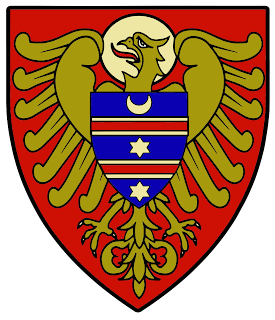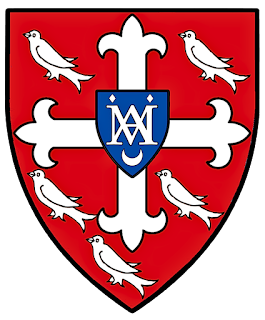 |
Arms of the Diocese of Quincy
Rendered by Chad Krouse, 2025 |
Over the past 10 years, I've diligently combed through archives across the US and Canada on my quest to uncover the heraldic work of Pierre de Chaignon la Rose (1872-1941). I have met so many archivists and volunteers who are passionate about the organizations whose histories they maintain. Sometimes I am lucky and find answers, other times not so. Today, however, was one of those good days.
During the 28th annual convention of the Episcopal Diocese of Quincy, which met on May 16-17, 1905 in the Cathedral of St. John, the assembly voted to officially adopt a coat of arms designed by la Rose (Diocese of Quincy, 1906, pages 34-35). Based on my data, now hovering around 250 institutional coats designed by la Rose, the arms for the Diocese of Quincy was the first coat la Rose designed for an Episcopal diocese.
 |
| The seal of the Diocese of Quincy designed by la Rose and found upon the bishop's cathedra inside St. John's Parish and Cathedral in Quincy, IL. Photo courtesy of The Rev. Patrick Smith, Rector. Note the diocese's motto, Jehovah Jireh, placed in the base of the vesica piscis. |
There is something else, however, that makes this coat extra special--keep reading.
The blazon for the arms of the Diocese of Quincy: Argent, between two pallets wavy Azure debruised in fesse, a cross quadrate Gules, thereon seven mascles conjoined three, three, and one Or.
An article appearing in The Living Church (1906), offers this description for the diocese's arms:
"The story told upon the shield is an interesting one and descriptive of the location, the history, the work, and the aspirations of the diocese. One versed in heraldry might read the shield as follows: The land between the rivers, of military associations where the Anglican Communion has spread the gospel net, which land is Quincy and whose church sends influences beyond the rivers. This is a free translation, very free, but better understood to-day than the language of ancient heraldry.
"The diocese includes a little more of the State of Illinois than was in what was known as the 'Military Tract,' a tract reserved after the war of 1812 to reward the soldiers. This fact, and the other one that within the diocese the Federal Government has its greatest arsenal, will account for the 'Military Associations.'
"An interesting fact is that the lozenge like the devices in the centre of the shield arranged as these are, 3, 3, and 1 , in heraldry mean both Quincy and the gospel net. The motto 'Jehovah Jireh,' chosen as all will remember by Bishop Chase, while it may not properly be included in the design is correctly placed in the rim" (page 1007).
Furthermore, DeKay (1993) notes that the arms of the diocese prominently features those from the "de Quincy family, Earls of Winchester, were [blazoned] 'gules, seven mascles conjoined, 3, 3, 1 or'" (page 36). All of this background information is great, but there's more.
 |
Banner of arms for the Diocese of Quincy.
Rendered by Chad Krouse, 2024. |
In Wright (1908), we learn that not only did la Rose design arms for the diocese, but also arms for its cathedral of St. John (page 244). This is the special coat that I've been pinning to see.
The only way I could find these arms was to contact The Rev. Patrick Smith, Rector of St. John's Parish and Cathedral, who so kindly sent me these photographs today. The parish and building are now affiliated with the Anglican Church. Moreover, Wright (1908) notes that the reredos was designed by none other than the Boston-based firm of Ralph Adams Cram (1863-1942). Wherever there is Cram, and heraldry is involved, la Rose is surely not far behind.
 |
| The arms of St. John's Cathedral carved onto the reredos inside St. John's Parish and Cathedral in Quincy, IL. Photo courtesy of The Rev. Patrick Smith, Rector. |
The arms of St. John's Parish and Cathedral are blazoned: Azure, on an eagle displayed Argent haoled Or, an escutcheon Gules thereon seven mascles conjoined three, three, and one Or.
 |
Arms of St. John's Cathedral with added external ornaments
Rendered by Chad Krouse, 2025 |
Now, we have the first known design from la Rose for a cathedral or parish in The Episcopal Church--all subject to change as the research progresses. Through the arms of St. John's Cathedral, we encounter for the very first time la Rose's method for showing unification and differencing. The escutcheon on the displayed eagle is a clear reference to the cathedral's ownership by the Diocese of Quincy. In this one coat of arms, la Rose not only differences the established de Quincy coat, but does so in a rather genius way which shows unification at the same time.
 |
Unification and differencing by way of the seven mascles
Rendered by Chad Krouse, 2025 |
The altar and reredos in St. John's Cathedral were dedicated on July 7, 1907 (Wright, 1908, page 244). Thus, it is likely--given the time lag between mailing designs, actual construction, to final dedication--la Rose designed these arms between 1905-1906.
La Rose would use the displayed and aureoled eagle for St. John in several future designs, as well as charge heraldic creatures with an escutcheon showing unification.
 |
Arms of St. Francis de Sales Seminary (St. Francis, WI) designed by la Rose.
Rendered by Chad Krouse, 2024. |
 |
| Arms of St. Edward's Seminary (Kenmore, WA) designed by la Rose in 1931. Rendered by Chad Krouse, 2024. |
If you're interested to read more about the arms of St. Edward's Seminary, click here to see one of my first posts regarding la Rose. La Rose continues to keep me on my toes with how he uses charges, tinctures, and metals to either show unification or differencing in his work. What is truly fascinating, at least to me, is that he worked out a logical solution to this problem very early in his heraldic career. La Rose would continue to refine his methodology over the years, and I have many examples in my data. Today was a good day.
Works Cited
DeKay, Eckford. (1993). Heraldry in the Episcopal Church. Acorn Press.
Diocese of Quincy (1906). The 28th annual convention of the Diocese of Quincy. Review Printing Company.
The Living Church (1906). Diocesan seal for Quincy. The Living Church, vol 35(24), 1007.
Wright, J. (1908). Some notable altars in the Church of England and the American Episcopal Church. MacMillan Company.





.JPG)

.png)







%20(1).png)
























